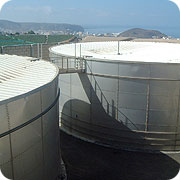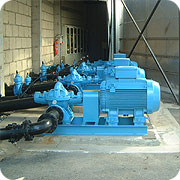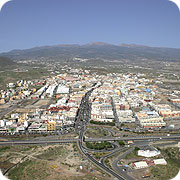Water Supply and sewerage
We efficiently manage the integral water cycle.
Although water is apparently a natural product, it will only be ready for consumption if it is permanently monitored by specialized professionals who intervene throughout the entire water cycle process.
The integral water cycle includes from the collection, purification and treatment of water collected from the natural environment, to its distribution and collection of used water for its subsequent purification and return to the environment from which it was obtained in optimal conditions that do not harm the environment. In short, the process covers everything from the supply of drinking water to the treatment of wastewater.
Aqualia controls all the phases of the integral water cycle down to the smallest detail, pursuing the optimization of resources to promote Sustainable Development.
Supply
The supply of drinking water consists of the collection of raw water, its purification and subsequent distribution for consumption.

Catchment
Surface water, groundwater, seawater and brackish water are normally used for catchment.
In the catchment area, waste and vegetation removal equipment is installed. To convert these resources into drinking water, the raw water has to be collected (catchment) and a more or less complex treatment has to be applied depending on the quality of the source water (raw water).
This process is carried out in Drinking Water Treatment Plants (DWTP).
Desalination
Desalination is a process that starts with raw water with a certain salinity, from which two flows are obtained, one with a low concentration of salts (product water) and the other with the remaining dissolved salts (brine).
The seawater is collected by wells located a few meters from the beaches or directly from the river deltas or the sea inlets, and pumped to a tank upstream of the desalination plant.
Once in the desalination plant, the water is subjected to decantation and filtration, among other treatments. In this way, it is in optimal conditions to undergo the reverse osmosis process (passage of water at high pressure through special membranes that reject brine particles). The treated water is then stored in tanks for remineralization and chlorination before being distributed to consumers.
This is a process that Aqualia carries out in many municipalities where it operates, but not yet in Colombia.

Drinking water storage
Once produced, drinking water is stored in reservoirs to guarantee supply to users, regardless of production capacity and consumer demand. The reservoirs thus make it possible to regulate and adjust the volumes of water available.
As a general rule, the reservoirs are located at elevated points, which allows them to be distributed by gravity without having to resort to pumping.
Supply network
The drinking water stored in the reservoirs is supplied to consumers through the supply network.
The care and attention of the supply network is essential to:
- Avoid possible leaks that involve loss of drinking water.
- Identify as soon as possible any breakdown that could lead to an interruption of the supply.
- Repair or replace as soon as possible any defective piping to guarantee the quantity and quality of water supplied to consumers.
- Carry out improvements to guarantee the supply.
- Maintain the level of the reservoirs to ensure an optimal water supply.
Sewage network
The water consumed in homes, businesses and industries, once used, is conducted through the sewage network and the Wastewater Pumping Stations -EBAR- to be processed and recycled.

Purification
Wastewater Treatment Plants (WWTP)
WWTPs play a fundamental role in the water cycle. They process and recycle water before returning it to the natural environment. The construction, operation and maintenance of these systems are complex and very costly, but the quality of our environment depends on it.
WWTPs eliminate physicochemical and biological pollution and are classified according to the processes involved: primary, secondary and tertiary treatment.
The process of elimination of pollution in WWTPs with primary treatment is based basically on sedimentation.
Those with secondary treatment, in addition to the previous process, add a biological stage.



